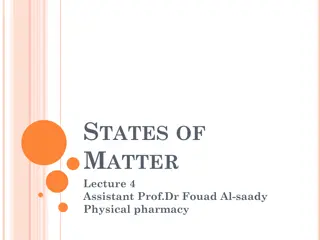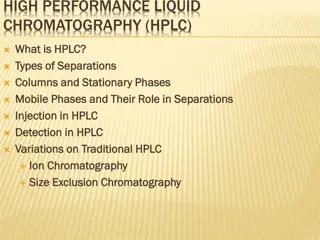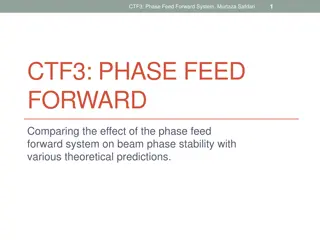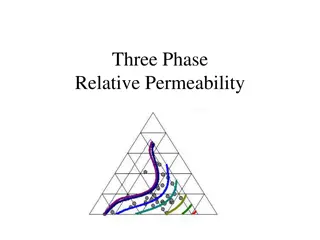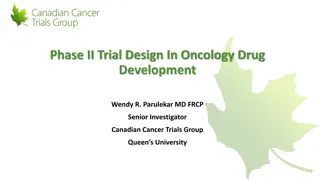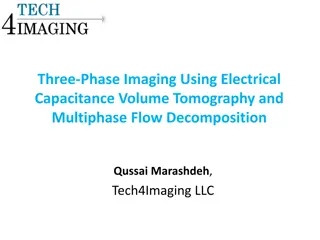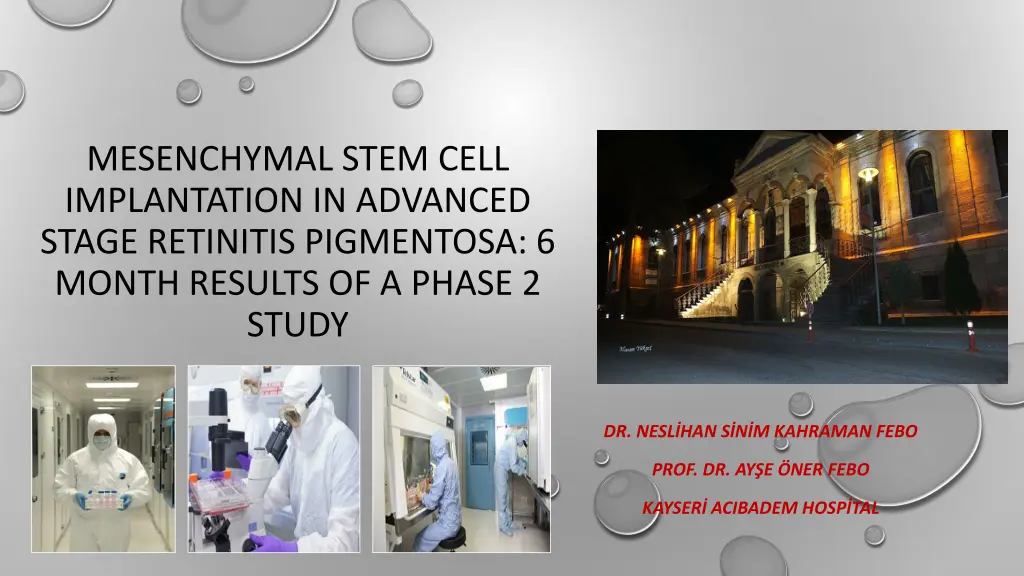
Advanced Stage Retinitis Pigmentosa Stem Cell Implantation Study
"Explore the 6-month results of a phase 2 study on mesenchymal stem cell implantation in advanced stage retinitis pigmentosa (RP). This innovative treatment option shows promising improvements in visual function, visual acuity, and visual field construction without any adverse effects. Learn about the methodology, outcomes, and potential for restoring vision in RP patients through this cutting-edge approach."
Download Presentation

Please find below an Image/Link to download the presentation.
The content on the website is provided AS IS for your information and personal use only. It may not be sold, licensed, or shared on other websites without obtaining consent from the author. If you encounter any issues during the download, it is possible that the publisher has removed the file from their server.
You are allowed to download the files provided on this website for personal or commercial use, subject to the condition that they are used lawfully. All files are the property of their respective owners.
The content on the website is provided AS IS for your information and personal use only. It may not be sold, licensed, or shared on other websites without obtaining consent from the author.
E N D
Presentation Transcript
MESENCHYMAL STEM CELL IMPLANTATION IN ADVANCED STAGE RETINITIS PIGMENTOSA: 6 MONTH RESULTS OF A PHASE 2 STUDY DR. NESL HAN S N M KAHRAMAN FEBO PROF. DR. AY E NER FEBO KAYSER ACIBADEM HOSP TAL
AIM Retinitis pigmentosa (RP) is a potentially blinding disease with severe visual impairments detected in early ages of life. The presence of nyctalopia, visual field construction from periphery to the fovea, bone spicule pigmentation in the retina and a reduction in electroretinograms (ERG) are seen as the findings of the disease. There is no curative treatment for the disease up to date. New approaches including restoring defective genes and stem cell transplantation have been under investigation
Stem cell implantation, following the succesful results of experimental studies in recent years, is now available as a treatment option to restore visual function in these diseases. This study aimed to investigate the safety and efficacy of suprachoroidal mesenchymal stem cell (MSC) implantation inadvanced stage retinitis pigmentosa patients. In this study we use umblical cord- derived mesenchymal stem cells (MSCs) which are a non-embriyonic stem cells.
METHOD The worse eye of the patient was operated by Limoli Retinal Restoration Technique and received suprachoroidal MSC implantation. Patients were evaluated on the first day, first week, first month, third and sixth month postoperatively. BCVA, anterior segment and fundus examination, color photography, optical coherence tomography (OCT), visual field examination were carried out at each visit. Fundus fluorescein angiography (FFA) and multifocal electroretinography (mf ERG) recordings were performed at the end of the first, third and sixth month and anytime if necessary during the follow-up.
RESULTS All 13 patients completed the sixth month follow-up period. None of them had any systemic or ocular complications. Eleven of the 13 patients experienced visual acuity improvement, the visual acuities of the remaining two patients were the same. All of the patients had improvements in the visual field and mf ERG recordings. We found no ocular pathologies on FFA of the patients.
Multifocal ERG of a patient before and six months after stem cell treatment Vision: pretreatment: 1 meter hand motion after treatment: 2 meters counting finger
Visual fields of a patient before first and sixth months after the treatment Vision: before treatment o.o5 snellen line after treatment 0,15 Snellen line
DISCUSSION Clinical studies have shown that the implantation of stem cells is safe and has no serious adverse effects in patients with advanced stage retinitis pigmentosa. In the Reticell-clinical study, the researchers analyzed the effect of intravitreal use of autologous bone marrow-derived MSCs (BMSSCs) on the quality of life of 20 patients with RP. Three months after treatment, they found a statistically significant improvement in patients' quality of life. Seventeen patients with bilateral visual loss due to RP were included in Stem Cell Ophthalmology Treatment Study SC (SCOTS) protocol and followed for at least 6 months. Thirty three eyes were treated and 15 eyes had an increase, 15 eyes remained stable and 3 eyes deteriorated. *Park SS, Bauer G, Abedi M, Pontow S, Panorgias A, Jonnal R,Zawadski RJ, Werner JS, Nolta J. Intravitreal autologous bone marrow CD34+ cell therapy for ischemic and degenerative retinal disorders: preliminary phase 1 clinical trial findings. Invest Ophthalmol Vis Sci 2015 56(1):81-9. *Siqueira RC, MessiasA, Messias K, Arcieri RS, Ruiz MA, Souza NF, Martins LC, Jorge R. Quality of life in patients with retinitis pigmentosa submitted to intravitreal use of bone marrow-derived stem cells (Reticell -clinical trial). Stem Cell Res Ther. 2015 Mar 14;6:29 * ner A, G nen ZB, Sinim N, etin M, zkul Y. Subretinal adipose-tissue derived mesenchymal stem cell implantation in advanced stage retinitis pigmentosa: A Phase I clinical safety study. Stem Cell Research and Therapy, 2016 Dec 1;7(1):178. *Weiss JN, Levy S Stem Cell Ophthalmology Treatment Study: bone marrow derived stem cells in the treatment of Retinitis Pigmentosa. Stem Cell Investig. 2018 Mar ;5:18.
In this study, we use Limoli retinal restoration technique as a stem cell implantation technique without ocular complication and we found an improvement in visual performance of the treated eyes at 6 months follow-up. And also we use first time human umbilical cord-derived mesenchymal stem cells (MSC) which is widely used as a rich and ethically acceptable stem cell source It is known to have higher proliferative potential than other MSC sources such as bone marrow and adipose tissue. *Li T et al. Human umbilical cord mesenchymal stem cells: an overview of their potential in cell-based therapy. Expert Opin Biol Ther. 2015 Russell, A. L., Lefavor, R., Durand, N., Glover, L., & Zubair, A. C. Modifiers of mesenchymal stem cell quantity and quality. Transfusion, 2018. 58(6), 1434-1440.
CONCLUSION Stem cell based treatment methods show promising results in retinal diseases that do not currently have curative treatment options. We believe that UCMSCs can be an effective source of stem cells. Stem cell therapies will play an important role in the treatment of degenerative retinal diseases





